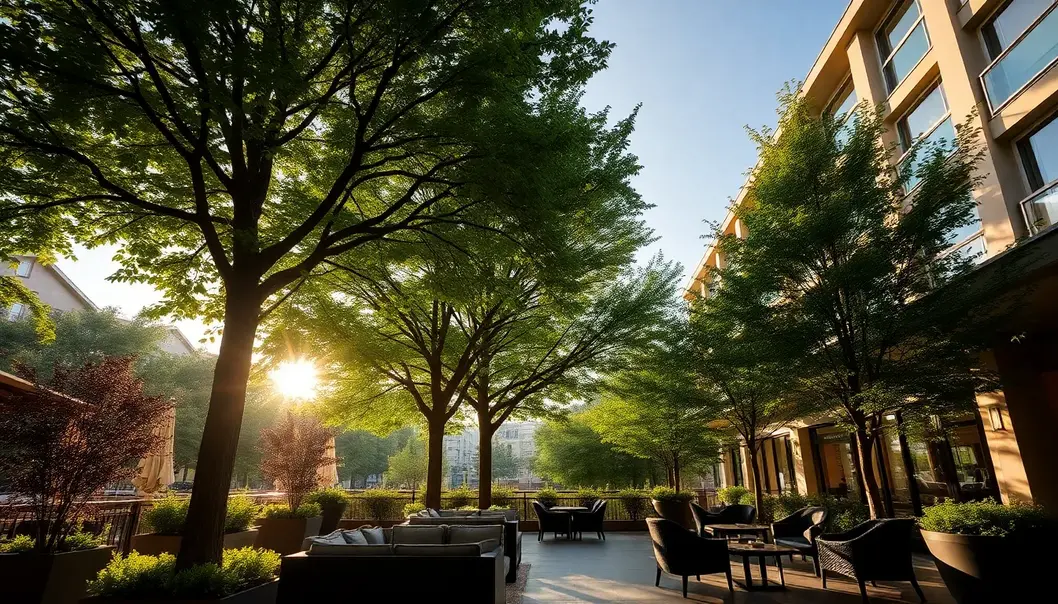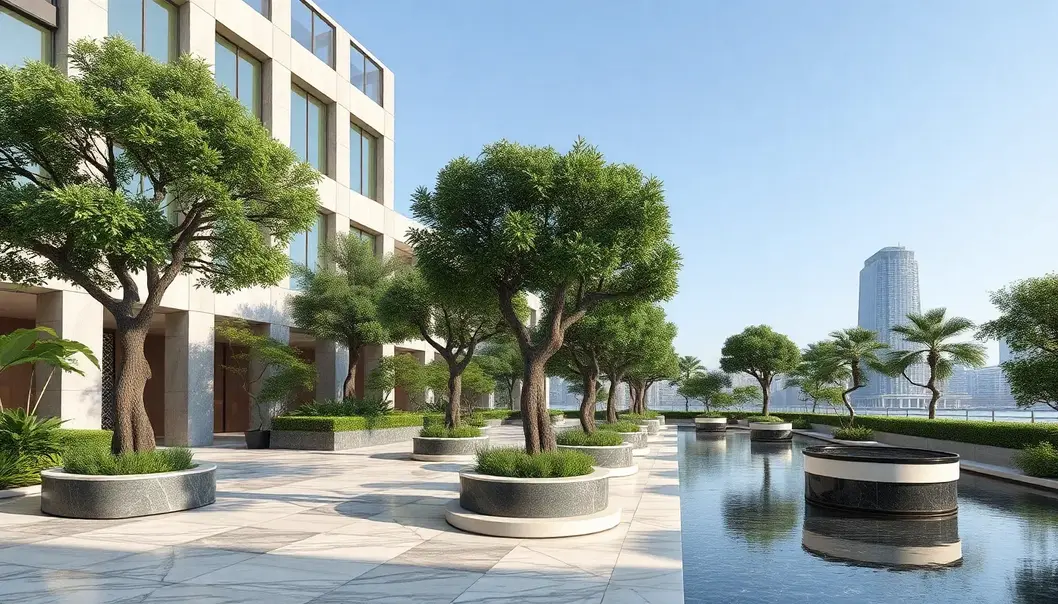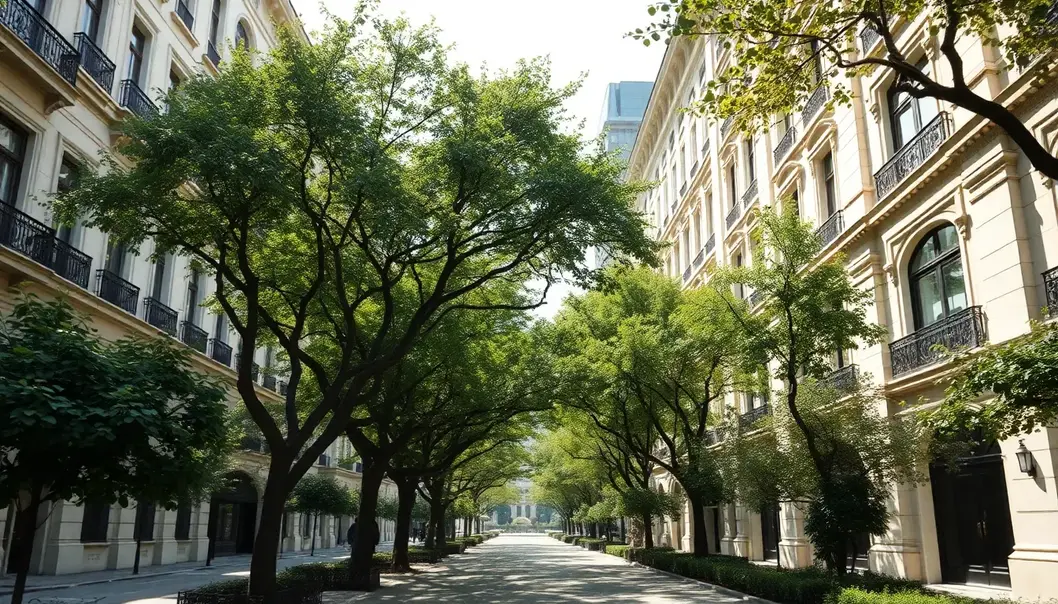In an age where urban luxury is defined not only by opulent interiors but also by the extravagance of comfort, the role of trees transcends mere ornamentation. They stand as silent guardians, providing not just beauty but a sophisticated solution to modern urban challenges. These stalwarts of nature possess an unrivaled ability to bestow refreshing coolness amidst the concrete sprawl, creating sanctuaries of tranquility. As trees weave their leafy magic, they transform not only the landscape but also elevate the experience of refined urban living. Join us as we explore how trees enhance both biodiversity and luxury, crafting an urban tapestry that is as elegant as it is sustainable.
Nature’s Canopy: A Luxurious Shield

Urban trees stand as silent sentinels, crafting a magnificent canopy under which city dwellers find respite. These trees, far from mere decorative elements, transform bustling metropolitan spaces into luxurious refuges. Their cooling capabilities not only ease the oppressive heat of urban environments but also elevate the ambiance of upscale locales. By harnessing the natural elegance of these towering giants, cities can offer a peculiar blend of opulence and ecological sustainability.
Trees reduce ambient temperatures through a process known as transpiration. In this natural cooling system, water absorbed by the roots is released into the atmosphere, creating a cooling effect much like perspiration does in humans. This phenomenon, coupled with the shade provided by the tree canopies, delivers a substantial decrease in temperatures, enhancing comfort in heat-soaked urban landscapes. Moreover, this cooling prowess of trees significantly reduces the need for air conditioning in adjacent buildings, leading to energy savings and a reduced environmental footprint.
Among the species famed for their effective cooling are the London Plane, American Elm, and the Quercus family. These majestic stalwarts have broad canopies and a dense foliage structure that amplify their shade-giving capacities. The London Plane, in particular, is celebrated for its resilience to urban pollution, making it an ideal candidate for city planting. American Elms, with their graceful arching branches, not only provide extensive shade but also exude a timeless elegance, enhancing the luxurious feel of urban boulevards and promenades.
In metropolitan areas, opting for such prestigious arboreal additions is a clear testament to the fusion of design and practicality. Luxury developments increasingly incorporate these species, knowing that they offer an unparalleled sense of peace and grandeur. Thoroughfares lined with stately trees evoke a serene sophistication, inviting affluent shoppers and residents to meander through nature’s green corridors. The interplay of light and shadow under the tree canopy creates a dynamic visual experience, akin to strolling through the galleries of art and culture that these neighborhoods often boast.
Elegantly integrating these trees into urban environments requires a nuanced understanding of both horticulture and landscape architecture. Landscape architects work meticulously to ensure these natural structures seamlessly mesh with contemporary urban designs. By doing so, they create pockets of refuge and beauty that rival indoor luxury spaces. As urban canopies grow and mature, so does their capacity to bestow realistic grandeur upon the settings beneath them, offering inhabitants and visitors a tangible link to nature’s splendor.
Crafting Cool: Trees as Urban Sculptures

In the ever-evolving world of luxury urban design, the assimilation of trees as living sculptures is gaining momentum. These natural elements seamlessly blend with architectural sophistication, providing both visual allure and functional benefits. As urban spaces strive for exclusivity and refinement, trees are artfully integrated to enhance opulent environments, transforming them into masterpieces of modern design.
Innovative Landscaping Techniques
Incorporating trees as focal points within urban luxury settings demands creative landscaping techniques. Designers are increasingly using tree formations that emphasize the natural symmetry and elegance of each specimen, akin to a sculptor shaping masterpiece from raw stone. Strategic pruning and careful selection of tree species allow for curated growth patterns, ensuring that each tree complements its surroundings and contributes to the ambiance of the space.
Unique installations where trees are paired with complementary materials, such as sleek metals or textured ceramics, further accentuate their artistic appeal. These combinations create a harmonious interplay between natural and man-made elements, offering a sense of balance and tranquility. Such harmonization of form and function is essential in crafting urban landscapes that prioritize eco-friendly luxury.
Trends in Eco-Friendly Luxury Developments
With an increased focus on sustainability, luxury developments are embracing eco-friendly practices. Trees, with their innate cooling properties, are central to these projects. By strategically positioning trees along wind paths and optimizing their canopy density, urban planners can significantly reduce ambient temperatures, providing a cooling effect that limits the need for artificial climate control.
Moreover, the aesthetic placement of trees contributes to an urban sanctuary concept, where residents and visitors can find solace amidst the hustle of city life. This trend not only enhances ecological responsibility but also elevates the experiential quality of urban spaces, adding intrinsic value to upscale real estate.
Exemplary Urban Projects
Several avant-garde projects underscore the pivotal role of trees in crafting luxurious urban environments. In some, trees are chosen and arranged based on their seasonal attributes, ensuring a dynamic and ever-changing skyline that captivates throughout the year. This deliberate planning results in a living gallery, where each tree acts as both an individual piece of art and a contributor to the collective aesthetic.
Incorporating native species that adapt well to the urban climate also supports biodiversity, adding another layer of luxury defined by a commitment to sustaining local ecosystems. Such thoughtfully designed landscapes offer more than just beauty—they embody an evolution towards an opulent yet environmentally conscious urban lifestyle.
Ultimately, by viewing and integrating trees as urban sculptures, cities can foster environments where nature and luxury coexist harmoniously. This blend of artistry and ecology not only enhances the aesthetic of urban spaces but also promotes a more sustainable and elegant future.
To further explore how natural elements can transform spaces, consider this insightful read.
Final words
In the lavish embrace of urban elegance, trees whisper the song of comfort and sustainability. By integrating these natural marvels into cityscapes, we not only cool our surroundings but sculpt spaces of sublime sophistication. These silent sentinels enrich our urban environments with their serene presence, proving that true luxury transcends mere aesthetic appeal. By embracing the arboreal, we elevate urban living to new heights of elegance.
Explore how to enhance your urban lifestyle with the elegance of nature. Discover luxury projects that seamlessly integrate natural cooling.
Learn more: https://luxurylivingwithtrees.com
About us
At Luxury Living With Trees, we specialize in transforming urban landscapes into havens of elegant tranquility. Our bespoke designs incorporate premium tree species that not only provide cooling but enhance the aesthetic appeal of upscale developments. We partner with architects and developers to create breathtaking urban oases that invite luxury shoppers to embrace the serene beauty of nature. Visit us to explore how nature’s elegance can redefine urban luxury.

